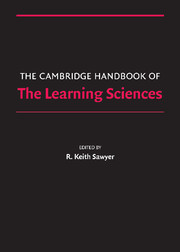Book contents
- Frontmatter
- Contents
- Preface
- Contributors
- 1 Introduction
- PART I FOUNDATIONS
- 2 Foundations and Opportunities for an Interdisciplinary Science of Learning
- 3 Constructionism
- 4 Cognitive Apprenticeship
- 5 Cognitive Tutors
- 6 Learning in Activity
- 7 Knowledge Building
- PART II METHODOLOGIES
- PART III THE NATURE OF KNOWLEDGE
- PART IV MAKING KNOWLEDGE VISIBLE
- PART V LEARNING TOGETHER
- PART VI LEARNING ENVIRONMENTS
- Afterword: After How Comes What
- Epilogue: The Fundamental Issue in the Learning Sciences
- Author Index
- Subject Index
- References
4 - Cognitive Apprenticeship
Published online by Cambridge University Press: 05 June 2012
- Frontmatter
- Contents
- Preface
- Contributors
- 1 Introduction
- PART I FOUNDATIONS
- 2 Foundations and Opportunities for an Interdisciplinary Science of Learning
- 3 Constructionism
- 4 Cognitive Apprenticeship
- 5 Cognitive Tutors
- 6 Learning in Activity
- 7 Knowledge Building
- PART II METHODOLOGIES
- PART III THE NATURE OF KNOWLEDGE
- PART IV MAKING KNOWLEDGE VISIBLE
- PART V LEARNING TOGETHER
- PART VI LEARNING ENVIRONMENTS
- Afterword: After How Comes What
- Epilogue: The Fundamental Issue in the Learning Sciences
- Author Index
- Subject Index
- References
Summary
Throughout most of history, teaching and learning have been based on apprenticeship. Children learned how to speak, grow crops, construct furniture, and make clothes. But they didn't go to school to learn these things; instead, adults in their family and in their communities showed them how, and helped them do it. Even in modern societies, we learn some important things through apprenticeship: we learn our first language from our families, employees learn critical job skills in the first months of a new job, and scientists learn how to conduct world-class research by working side-by-side with senior scientists as part of their doctoral training. But for most other kinds of knowledge, schooling has replaced apprenticeship. The number of students pursuing an education has dramatically increased in the last two centuries, and it gradually became impossible to use apprenticeship on the large scale of modern schools. Apprenticeship requires a very small teacher-to-learner ratio, and this is not realistic in the large educational systems of modern industrial economies.
Even in modern societies, when someone has the resources and a strong desire to learn, they often hire a coach or tutor to teach them by apprenticeship – demonstrating that apprenticeship continues to be more effective even in modern societies. If there were some way to tap into the power of apprenticeship, without incurring the large costs associated with hiring a teacher for every two or three students, it could be a powerful way to improve schools.
- Type
- Chapter
- Information
- The Cambridge Handbook of the Learning Sciences , pp. 47 - 60Publisher: Cambridge University PressPrint publication year: 2005
References
- 52
- Cited by



